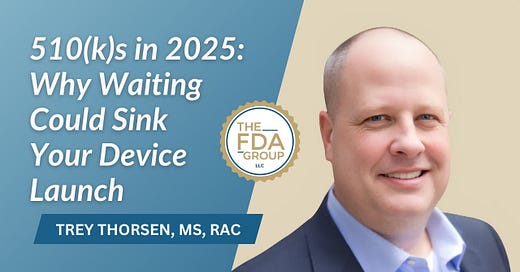Questions about FDA delays have some device makers hesitating on their product submission plans. Given how many products on the device side come to market through the 510(k) pathway, it’s where we’ve personally observed the most questions about what to do right now.
We just sat down with one of our senior 510(k) consultants, Trey Thorsen, to try to separate signal from noise and lay out a practical game plan for companies that need market clearance this year. Watch our discussion above, get the highlights below, and get in touch with us if a premarket notification is in your near future.
What’s really happening inside the FDA right now?
In short:
The agency is still meeting its MDUFA review-clock goals. Formal user-fee timelines remain intact despite staffing cuts.
Early signs of slowdown only seem to be surfacing outside those statutory clocks—informal correspondence, import-hold follow-ups, and other “desk” queries are taking longer in some instances.
Separate from submissions, and more on the inspection front, we’ve been seeing an influx of companies bringing 483s to us for response support that contain numerous “granular” observations, which may reflect pressure on newer investigators to “show their work.” Issues that may have been regarded as minor enough to be handled informally on-site are now being formally documented in inspection observations.
The bottom line: If your submission falls under MDUFA, the official clock still rules—but be ready for potentially slower responses elsewhere.
The hidden cost of waiting
Trey brought up three things firms should be thinking about that might not be obvious:
Backlog risk. When everyone waits for a “better time,” they create the very bottleneck they hoped to avoid. We saw this firsthand during the pandemic. Submitting now can put you ahead of that wave.
Competitive risk. A bolder rival can seize market share while you sit on a finished dossier.
Cash-flow risk. For startups with a single product, delayed clearance could mean delayed revenue and fresh investor dilution.
Trey’s advice is blunt:
“If your substantial-equivalence case, testing, and the other components of your submission package are buttoned up, I’d say submit now.”
Be extra mindful of the trouble spots reviewers flag first
Trey often points out a handful of areas that frequently trip up submissions. Now is the time you scrutinize them even more before submitting:
Device description: If a reviewer still can’t picture how the device works after two reads, expect questions. Keep it clear, not tech-jargon heavy. As Trey has pointed out several times in our discussions of submission best practices, it’s often the case that a company’s engineers are the ones writing these descriptions since they’re closest to the details of the product. A problem arises when they write these descriptions too technically or in a way that implies a busy FDA reviewer will know the inner workings of their product type. Often, they won’t—and it leads to preventable clarifications. One of the most critical jobs of an outside regulatory consultant is to help translate engineering-speak into clear descriptions that FDA reviewers can understand.
Substantial-equivalence argument: A weak predicate match or unaddressed difference can sink the filing. Tighten the narrative before day 0.
Performance testing package: Incomplete reports, unclear acceptance criteria or failed endpoints left unexplained will stall the clock fast.
Use the pre-Sub strategically
A 60- to 75-day Pre-Sub can feel like a delay, yet it often saves months by surfacing FDA concerns early, especially on novel predicates or borderline indications. If any part of your equivalence or test plan feels shaky, ask first, submit later.
Watch our earlier discussion with Trey where he speaks to the advantages of Pre-Subs at length (as well as many other 510(k) best practices):
When to bring in a consultant
The ideal hand-off is just before design freeze and well ahead of verification and validation testing. That timing lets a consultant:
Pressure-test your predicate logic.
Align test plans to guidance and standards.
Translate that “engineer-speak” into reviewer-friendly prose.
We find that firms that engage after testing—or worse, right before intended submission—force rework that burns both calendar and cash.
A quick action checklist for 2025 filers
Lock your predicate early. Confirm there’s no unanswered risk question.
Write the device description for a non-engineer. If a five-minute read doesn’t tell an outsider what problem you solve and how, rewrite.
Audit every test report. Verify each acceptance criterion is met or scientifically justified.
Schedule a Pre-Sub for gray areas. Don’t use the 510(k) itself to “float” questions.
Submit before the crowd does. Beat the backlog, secure revenue, outpace competitors.
Ready to move?
The FDA Group’s 510(k) specialists review, remediate, and author submissions every week, cutting confusion and cycle time. If your team wants an outside eye—or a full-service partner—learn more and start the conversation.
Who is The FDA Group?
The FDA Group helps life science organizations rapidly access the industry's best consultants, contractors, and candidates. Our resources assist in every stage of the product lifecycle, from clinical development to commercialization, with a focus on Quality Assurance, Regulatory Affairs, and Clinical Operations.
With thousands of resources worldwide, hundreds of whom are former FDA, we meet your precise resourcing needs through a fast, convenient talent selection process supported by a Total Quality Guarantee. Learn more and schedule a call with us to see if we’re a fit to help you access specialized professionals and execute your projects on time and on budget.
The FDA Group's Insider Newsletter is a reader-supported publication. To receive new posts and support our work, consider becoming a paid subscriber.







Share this post